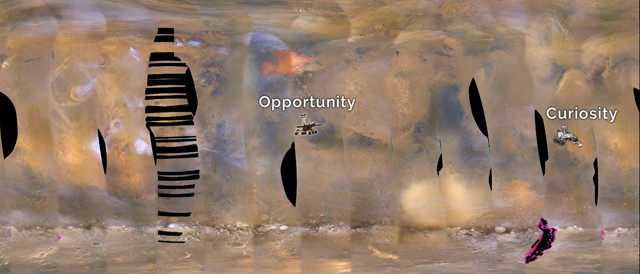
by Sarah Derouin Tuesday, July 3, 2018

A mosaic of satellite images (with gaps appearing black) shows a massive dust storm that raged on Mars in June, affecting both the Curiosity and Opportunity rovers. Credit: NASA/JPL-Caltech/MSSS.
With two rovers patrolling the surface of Mars, six spacecraft orbiting above it, and scientists here on Earth studying the Red Planet from afar, new findings are announced often. Here are a few of the latest updates.
A massive dust storm, first detected by NASA’s Mars Reconnaissance Orbiter on May 30, raged on Mars in June, smothering Perseverance Valley and the solar-powered Opportunity rover, prompting NASA engineers to power it down to conserve battery life. By June 10, the storm had grown to 18 million square kilometers — larger than North America. By June 19, it encircled the planet, increasing dust at Gale Crater, where NASA’s Curiosity rover is located. The dust storm is similar in size to a storm observed by Viking I in 1977, but not as large as a 2007 dust storm, which the Opportunity rover, on Mars since 2004, successully weathered.
Curiosity has unearthed “tough” organic molecules after drilling into 3.5-billion-year-old Mars mudstone in Gale Crater. The finding suggests that the planet might have supported life in the past, although the discovery isn’t proof of life. Using the Sample Analysis at Mars (SAM) instrument suite, the rover found thiophenic, aromatic and aliphatic organic compounds. “Finding ancient organic molecules in the top five centimeters of rock that was deposited when Mars may have been habitable, bodes well for us to learn the story of organic molecules on Mars with future missions that will drill deeper,” said Jen Eigenbrode, a NASA biogeochemist, in a statement. Using SAM, researchers also measured methane levels on Mars for the past five Earth years (roughly 2.5 Martian years) and observed subtle, yet clear seasonal changes in atmospheric methane levels between 0.24 and 0.65 parts per billion by volume. The seasonal cycle could be explained by the near-surface rocks taking up methane in cold winter and releasing it during warmer summer.
Seasonal temperature changes on Mars cause frozen carbon dioxide in Martian soils to sublimate in the spring, turning from a solid to a gas (and vice versa in the fall). Researchers have published new findings in Scientific Reports about how the changing seasons — and the effect of sublimating carbon dioxide — can affect Mars’ surface. Specifically, the team looked at elongated, networked markings on Martian sand dunes that form and disappear seasonally. The researchers suspected that sublimating carbon dioxide was the cause, so they built a low-humidity chamber to test how dry ice might change a granular surface. The researchers found that temperature differences between the dry ice and sand created a vapor layer, helping levitate the dry ice. In the experiment, the stationary blocks eroded the sand quickly, creating pits and levees, similar to those seen on Mars. “This process is really unlike anything seen to occur naturally on Earth — the bed appears fluidized and sand is kicked up in every direction,” study co-author Jim McElwaine of the Planetary Science Institute in Tucson, Ariz., and England’s Durham University, said in a statement.
Clays are ubiquitous on the surface of Mars, and ancient phyllosilicate outcrops are found all over the planet. In a new study in Nature, scientists propose that a steamy atmosphere early in Mars’ history could have helped make much of this clay. “The basic recipe for making clay is you take rock and you add heat and water,” said Kevin Cannon, a postdoctoral researcher at the University of Central Florida and lead author of the study, in a statement. Cannon’s team suggests that as early Mars was transitioning from a molten to solid planet, a warm, water vapor-rich atmosphere blanketed the new crust, creating clays. “This primordial atmosphere created by a magma ocean would have been the hottest and wettest Mars ever was. It’s a situation where you could pervasively alter the crust and then just shuffle those materials around afterward.” To test the theory, the team “cooked” basalt samples in temperature and pressure conditions that may have occurred when Mars’ crust was forming. After two weeks, the team saw significant alteration of the basalts. The researchers note that their findings could be tested on future Mars missions, by investigating alteration processes on Martian outcrops.
© 2008-2021. All rights reserved. Any copying, redistribution or retransmission of any of the contents of this service without the expressed written permission of the American Geosciences Institute is expressly prohibited. Click here for all copyright requests.